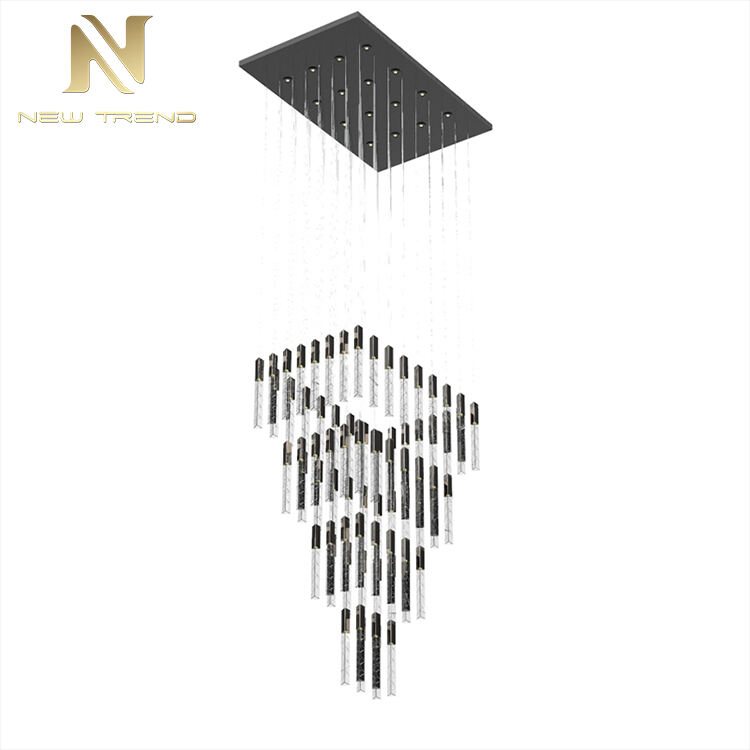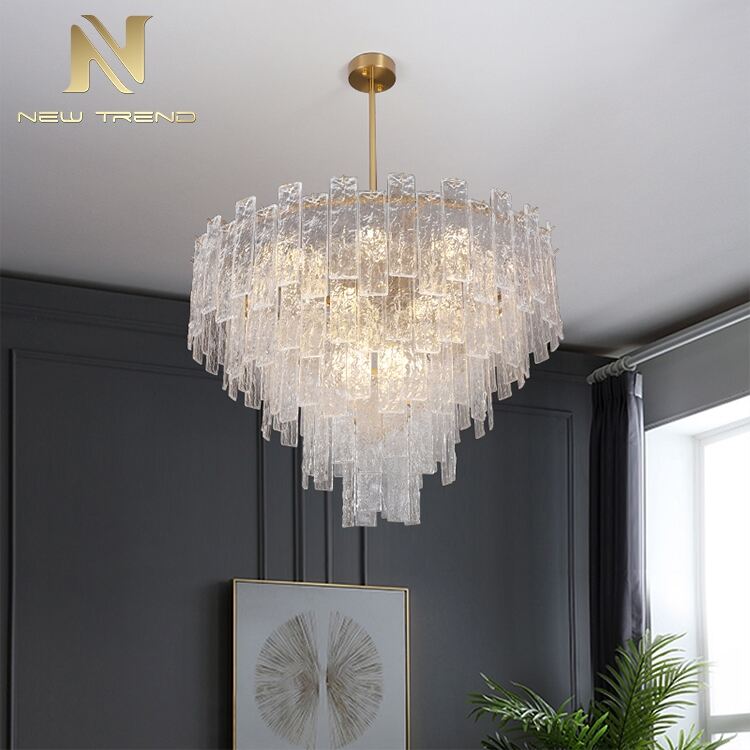Оценка пространства для пропорционального проектирования люстры
Понимание ограничений высоты потолков
При рассмотрении дизайна люстры понимание высоты вашего потолка является важным фактором. Большинство жилых помещений имеют потолки высотой от 8 до 10 футов, что существенно влияет на масштаб и пропорции вашей люстры. Высота определяет, насколько эффектной или сдержанной будет люстра в интерьере комнаты. Очень важно соблюдать минимальное расстояние в 7 футов от пола до нижней части люстры, чтобы избежать перекрытия обзора и обеспечить безопасность. Это правило помогает предотвратить несчастные случаи и гарантирует, что ваша люстра дополнит пространство, а не будет его перегружать.
Расчет идеальных размеров осветительной арматуры
Расчет оптимальных размеров люстры обеспечивает гармонию в помещении. Практический метод определения размера люстры заключается в сложении ширины и длины помещения в футах; эта сумма должна соответствовать диаметру люстры в дюймах. Например, для комнаты размером 12 на 16 футов диаметр люстры должен составлять около 28 дюймов. Кроме того, необходимо учитывать высоту осветительного прибора и его пропорциональное соотношение с окружающей мебелью и элементами дизайна, чтобы добиться сбалансированного эстетического восприятия. Такой подход позволяет согласовать люстру с существующим декором, усиливая общее визуальное воздействие.
Оценка динамики планировки гостиной
Планировка и динамика гостиной оказывают существенное влияние на размещение люстры. Грамотное расположение может создать акцентные зоны и оптимизировать использование пространства, превратив люстру в центральный элемент комнаты. Очень важно учитывать расстановку мебели и визуальные линии: люстру следует размещать так, чтобы она подчеркивала зону отдыха и усиливала визуальную целостность. Средний размер гостиной в США составляет около 16 футов на 20 футов, что позволяет правильно подобрать масштаб и место для люстры. При правильной установке люстра обеспечивает гармонию и свободу передвижения, создавая динамичное и уютное жилое пространство.
Современный стиль для модного дизайна
Принципы дизайна минималистичных люстр
В мире современного освещения минималистичные люстры обладают особенным шармом, который определяется простотой и функциональностью. Эти дизайны основаны на четких линиях и ненавязчивых формах, которые в совокупности усиливают характерный для современных интерьеров элегантный внешний вид. Среди ярких примеров можно отметить люстру «Solitario», известную своей простой, но инновационной конструкцией, напоминающей плавные линии и изящество. Благодаря акценту на простоте и практической пользе, минималистичные люстры обеспечивают ненавязчивое, но вместе с тем уверенное присутствие в помещении, гармонично сочетаясь с современным декором без его перегрузки.
Геометрические формы в современном освещении
Интеграция геометрических форм в дизайн люстр является увлекательным трендом современной индустрии освещения. Формы, такие как шары, кубы и треугольники, создают динамичный визуальный интерес и могут без усилий дополнить различные стили интерьера. Будь то смелые симметричные линии шестиугольной модели или элегантность каскадного кубического дизайна — эти формы предлагают универсальность и современный подход. Современные коллекции дизайнеров часто демонстрируют популярные геометрические люстры, которые не только повышают эстетическую ценность пространства, но и гармонируют с различными художественными и декоративными стилями, добавляя нотку математической красоты в искусство освещения.
Сочетание материалов для усиления визуального эффекта
Современная эпоха в дизайне люстр отмечает искусство сочетания различных материалов, таких как металл, стекло и дерево, что в результате создает визуально привлекательные изделия. Чтобы добиться гармоничного вида люстр из смешанных материалов, важно сохранять сбалансированный контраст, усиливающий пространство, а не перегружающий его. Удачные примеры включают дизайны, в которых матовые металлы сочетаются с прозрачным или матовым стеклом и акцентами натурального дерева, при этом каждый элемент подчеркивает достоинства других. Такое продуманное сочетание материалов не только выделяет эстетическую привлекательность осветительного прибора, но также подчеркивает безграничные возможности смешивания текстур и отделок в дизайне освещения.
Инновационные материалы в индивидуальных люстрах
Металлические отделки: латунь против матового черного цвета
Выбор между отделкой из латуни и матового черного цвета — это важное решение на этапе индивидуальная люстра дизайн, поскольку каждый из них предлагает уникальные эстетические качества, влияющие на атмосферу пространства. Латунь, известная своим теплым и роскошным блеском, хорошо сочетается с традиционными и классическими интерьерами, добавляя нотку элегантности. Напротив, матовый черный излучает современный и изысканный стиль, идеально подходя для современных интерьеров, стремящихся к сдержанной роскоши. Что касается долговечности, эксперты отрасли утверждают, что хотя латунь остается вне времени, матовый черный набирает популярность, что отражает переход к минималистичным тенденциям в современном дизайне. Выбор отделки в конечном итоге зависит от стиля помещения и желаемой атмосферы вашей люстры.
Использование элементов текстурированного стекла
Рифленые стеклянные элементы в дизайне люстр предлагают уникальный способ рассеивания света и создания завораживающих узоров. Такой выбор дизайна может превратить осветительный прибор из простого источника света в важную часть визуальной динамики помещения. Независимо от того, используется ли стекло с текстурой молоткового узора, травленое или матовое стекло, эти вариации могут существенно повлиять на общий дизайн. Высококачественное рифленое стекло обеспечивает долговечность и оптимальную эксплуатацию; эксперты часто подчеркивают его способность мягко рассеивать свет, предотвращая резкий блик и создавая теплую атмосферу. На самом деле, статистика демонстрирует рост предпочтения к люстрам, включающим рифленое стекло, с все большим количеством дизайнеров интерьеров, выбирающих этот инструмент дизайна для улучшения пространства.

Учет экологичных материалов
В условиях стремительного развития дизайна люстр устойчивость стала важным фактором. Растущий спрос на экологичные светильники побуждает дизайнеров, таких как специалисты компании Lampventure, применять переработанные металлы и древесину из устойчивых источников, чтобы минимизировать воздействие на окружающую среду. Эта тенденция отражена в предпочтениях потребителей — исследования показывают рост рынка осветительных приборов, изготовленных из устойчивых материалов. Бренды, придерживающиеся экологичных практик, используют такие материалы не только для привлечения клиентов, заботящихся об окружающей среде, но и для поддержки ответственных методов производства. В будущем важно отдавать предпочтение таким решениям, чтобы каждая люстра не только освещала пространство, но и соответствовала принципам устойчивого развития.
Интеграция умной технологии освещения
Светодиодная настройка для управления атмосферой
Светодиодная технология обеспечивает значительные преимущества в регулировке яркости и цветовой температуры, что делает ее революционным решением в дизайне индивидуальных люстр. Благодаря возможности настройки освещения под конкретные настроения и виды деятельности, светодиодная настройка без усилий преобразует атмосферу помещения. По данным Министерства энергетики США, светодиодные лампы потребляют как минимум на 75% меньше энергии и служат до 25 раз дольше, чем лампы накаливания, что повышает как энергоэффективность, так и экономическую эффективность. Многофункциональность светодиодного освещения позволяет пользователям наслаждаться персонализированными настройками, превращая любое пространство в убежище комфорта и стиля.
Энергоэффективные современные решения для освещения
Современные люстры теперь обладают впечатляющими показателями энергоэффективности, обеспечивая не только стильное освещение, но и долгосрочную экономию средств. Потребители все чаще требуют таких энергоэффективных решений, что обусловлено как экологическими проблемами, так и стремлением снизить расходы на коммунальные услуги. В отчете Международного агентства по энергетике говорится, что улучшение эффективности освещения может привести к сокращению мирового потребления энергии на 30% к 2030 году. Растущее осознание этого вопроса среди потребителей усиливает переход рынка на устойчивые варианты освещения, что свидетельствует о тенденции, которая, вероятно, усилится в ближайшие годы.
Функции совместимости с системами «умного дома»
Интеграция умных люстр с системами домашней автоматизации ознаменовала значительный прогресс в современных осветительных технологиях. Эти решения умного освещения обеспечивают дистанционное управление и автоматизацию, предоставляя непревзойденное удобство и эффективность для современного ритма жизни. Например, по данным исследования, проведенного Research and Markets, прогнозируется рост глобального рынка умного дома на 14% с 2021 по 2027 год, что демонстрирует растущий спрос на такие инновации. Эта тенденция не только улучшает повседневный комфорт, но и отвечает изменяющимся предпочтениям потребителей в отношении бесшовных и интуитивно понятных решений для дома.
Совместный процесс проектирования с экспертами
Сотрудничество с дизайнерами освещения
Сотрудничество с профессиональными дизайнерами освещения неоценимо при создании уникальных люстр. Эти эксперты обладают большим опытом, чтобы превратить видение клиентов в реальные проекты, отражающие их личный стиль и эстетические предпочтения. Процесс включает глубокие обсуждения и итерации эскизов, передающих суть того, чего желает клиент. Дизайнеры, такие как Джейн Доу из студии Lumina Lighting Studios, подчёркивают, что их роль заключается в интерпретации потребностей клиентов в практичные решения для освещения. Например, недавний проект, представленный Lumina, предусматривал разработку индивидуальной люстры для ресторана высокого класса, идеально сочетающей современный дизайн и винтажные акценты, что доказывает эффективность совместных усилий при проектировании.
Прототипирование и 3D-визуализация
Прототипирование является важным этапом в процессе проектирования люстр, позволяя внести ключевые корректировки до создания конечного продукта. Этот этап гарантирует, что дизайн будет не только визуально впечатляющим, но и функционально обоснованным. Инструменты 3D-визуализации совершили революцию в способности клиентов понимать и взаимодействовать с дизайнерскими концепциями. Программы, такие как Autodesk 3D Max и SketchUp, предоставляют платформу для просмотра изображений высокого разрешения, что позволяет принимать более обоснованные и уверенные дизайнерские решения. Отличным примером является компания Crystal Lights Inc., которая использует эти передовые инструменты для предоставления клиентам реалистичных визуализаций, помогая им представить, как индивидуальная люстра впишется в интерьер их помещений.
Балансирующая форма и функция
Создание идеального баланса между формой и функцией в дизайне люстр часто представляет собой сложную, но при этом благодарную задачу. Хотя эстетическая привлекательность играет важную роль, практические потребности освещения не должны страдать. Методы, такие как регулируемые подвесные цепи, настраиваемые параметры лампочек и модульные конструкции, позволяют достичь этого баланса. Эксперты отмечают, что проекты, такие как реализованный компанией Elegance Interiors проект, объединивший художественную оригинальность с оптимальным освещением для конференц-зала, служат ярким примером такого сочетания. Дизайнер освещения Джон Смит из компании Elegance Interiors утверждает, что настоящий успех достигается тогда, когда люстра не просто дополняет окружающую обстановку, но и улучшает её, обеспечивая визуальное удовольствие и высокую функциональность.
Раздел часто задаваемых вопросов
В: Как определить подходящий размер для моей индивидуальной люстры?
О: Рассчитайте размер, сложив ширину и длину вашей комнаты в футах. Полученная сумма должна соответствовать диаметру люстры в дюймах для достижения идеальной гармонии.
В: Какие материалы обычно используются в современных люстрах?
О: Современные люстры часто изготавливаются из комбинации металлов, стекла и дерева. Экологичные варианты, такие как переработанные металлы и древесина, становятся все более популярными.
В: Можно ли интегрировать умные технологии в мою индивидуальную люстру?
О: Да, «умные» люстры можно подключать к системам домашней автоматизации для удаленного управления и автоматизации, что повышает удобство.
В: Как добиться баланса между формой и функциональностью в дизайне люстры?
О: Используйте регулируемые элементы, такие как подвесные цепи и настраиваемые параметры ламп, чтобы обеспечить как эстетическую привлекательность, так и практические потребности освещения.



